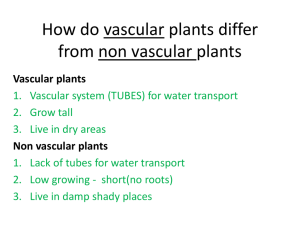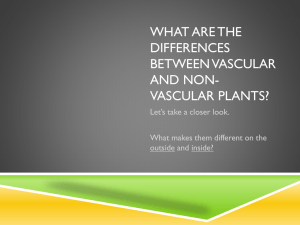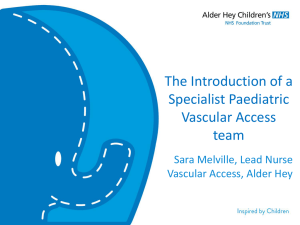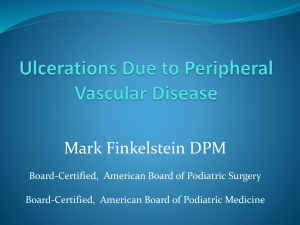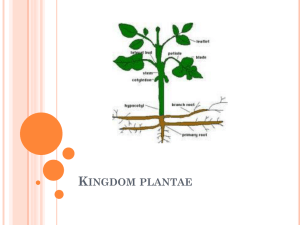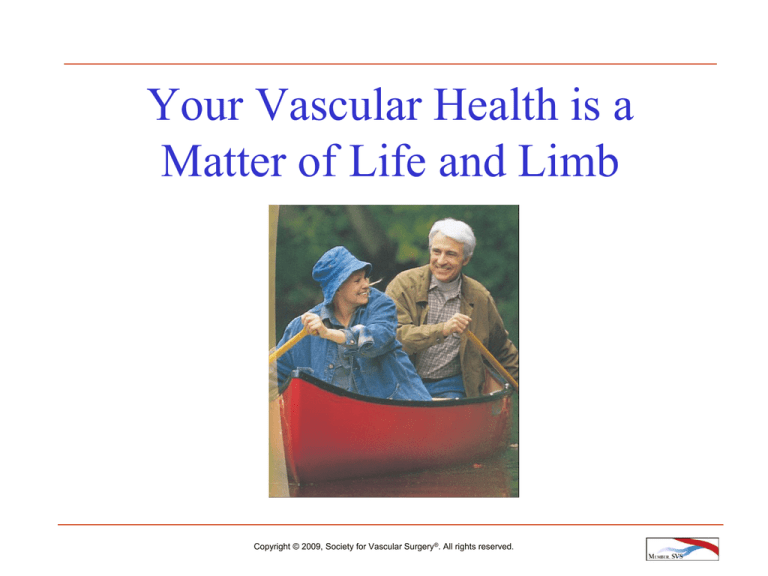
Your Vascular Health is a
Matter of Life and Limb
Copyright © 2009, Society for Vascular Surgery®. All rights reserved.
Your Vascular Health is a
Matter of Life and Limb
Name
Practice
Address
Phone
Website
Copyright © 2009, Society for Vascular Surgery®. All rights reserved.
Your Vascular System
All your veins and arteries
make up your vascular
system.
Arteries carry oxygen-rich
blood to your vital organs and
to your legs and feet, and
veins drain the blood back to
the heart.
Copyright © 2009, Society for Vascular Surgery®. All rights reserved.
Vascular Disease
As we age, our arteries tend to thicken, get stiff, and narrow
because of a build-up of plaque and cholesterol.
When this occurs in large and medium-sized arteries, it is
called atherosclerosis (hardening of the arteries).
When the narrowing happens in arteries leading to the
heart, it can cause a heart attack. The same situation in other
areas of the body can cause peripheral vascular disease.
Copyright © 2009, Society for Vascular Surgery®. All rights reserved.
Abdominal Aortic Aneurysm (AAA)
Your aorta is the largest artery
In your body.
An AAA occurs when the wall
of the aorta progressively
weakens and begins to bulge.
It may continue to enlarge and
eventually rupture if left
untreated causing severe
internal bleeding and possibly
death.
Copyright © 2009, Society for Vascular Surgery®. All rights reserved.
Abdominal Aortic Aneurysm (AAA)
Each year, 14,000 Americans die from rupture of an aortic
aneurysm according to the United States National Institutes
of Health, 2010.
Copyright © 2009, Society for Vascular Surgery®. All rights reserved.
Abdominal Aortic Aneurysm (AAA)
Who is at risk?
• People with a history of
atherosclerosis (hardening of
the arteries)
• Those with a family history
of AAA
• Those who smoke, have high
blood pressure, or chronic
lung disease
Copyright © 2009, Society for Vascular Surgery®. All rights reserved.
Abdominal Aortic Aneurysm (AAA)
What are the symptoms?
• A pulsing feeling in the abdomen
• Unexplained, severe pain in your abdomen or lower back
• Pain, discoloration, or sores on your feet (this is a rare
symptom)
Copyright © 2009, Society for Vascular Surgery®. All rights reserved.
Abdominal Aortic Aneurysm (AAA)
What can you do?
• See your doctor if you are at risk
• Stop smoking
• Maintain normal blood pressure
levels
• See a vascular surgeon to be tested
to see if you have an AAA.
• See a vascular surgeon if your doctor
diagnoses an AAA
Copyright © 2009, Society for Vascular Surgery®. All rights reserved.
AAA Medicare Screening Benefit
Medicare offers a free, one-time AAA ultrasound
screening for qualified seniors as part of the
Welcome to Medicare Physical Exam.
Men who have smoked 100 cigarettes sometime
during their life, and men and women with a family
history of AAA are eligible for this benefit.
The Welcome to Medicare physical must be
conducted during the first six months of enrollment.
Copyright © 2009, Society for Vascular Surgery®. All rights reserved.
Carotid Artery Disease (Stroke)
Carotid arteries are two main arteries
that carry blood from your heart, up
through your neck, to your brain.
Carotid artery disease results when
the carotid arteries become too narrow
or obstructed from plaque and limit
the blood flow to the brain.
Strokes result either from obstruction
of blood flow to the brain by the
plaque or when bits of plaque and
clots break off from the plaque and
flow to the brain.
Copyright © 2009, Society for Vascular Surgery®. All rights reserved.
Carotid Artery Disease (Stroke)
• Stroke is the fourth leading cause of death in the
United States according to 2010 National Vital
Statistics.
• Each year, 137,000 people die from a stoke.
• A large proportion of strokes are caused by plaque
in the carotid arteries.
• In 2010, the American Stroke Association
estimated that Americans would pay about
US$73.7 billion for stroke-related medical costs
and disability.
Copyright © 2009, Society for Vascular Surgery®. All rights reserved.
Carotid Artery Disease (Stroke)
What are the causes and risk factors?
•
•
•
•
•
•
•
•
•
Age
High blood pressure
Diabetes
Smoking
High cholesterol
Obesity
Lack of exercise
Irregular heartbeat
Family history of Atherosclerosis
(hardening of the arteries) and/or stroke
Copyright © 2009, Society for Vascular Surgery®. All rights reserved.
Carotid Artery Disease (Stroke)
Ministrokes (or transient ischemic attacks) are usually
temporary lasting a few minutes to a few hours, and should be
treated as serious medical emergencies requiring immediate
treatment. Some symptoms include:
•
•
•
•
•
•
Weakness, numbness, or tingling on one side of the body
Inability to control movement of a body part
Loss of vision or blurred vision in one or both eyes
Inability to speak clearly
Difficulty talking or comprehending what others are saying
Dizziness or confusion
Copyright © 2009, Society for Vascular Surgery®. All rights reserved.
Carotid Artery Disease (Stroke)
What can you do?
• See your doctor if you are at risk
or experience a ministroke
• Maintain normal blood pressure
levels
• Stop smoking
• Control cholesterol levels
• Maintain a healthy weight
• Exercise
• See a vascular surgeon if Carotid
Artery Disease is diagnosed, or to
be tested for this condition
Copyright © 2009, Society for Vascular Surgery®. All rights reserved.
Peripheral Arterial Disease (PAD)
Typically with age, the
peripheral arteries build up
plaque that narrows the
passageways causing them to
become stiff. PAD results
when the peripheral arteries
become too narrow or
obstructed and limit the
blood flow to the legs.
Copyright © 2009, Society for Vascular Surgery®. All rights reserved.
Peripheral Arterial Disease (PAD)
• One in every 20 Americans over the age of 50 has
peripheral arterial disease (PAD).
• PAD affects more than eight million people in the U. S.
• Individuals with PAD suffer a five-fold increased
relative risk of a cardiovascular ischemic event and
total mortality that is two to three fold greater than
those without PAD.
Copyright © 2009, Society for Vascular Surgery®. All rights reserved.
Peripheral Arterial Disease (PAD)
What are the risk factors?
•
•
•
•
•
•
•
Aging
Diabetes
Smoking
High cholesterol
Obesity
Lack of exercise
Males are more prone to PAD, but women are at
risk as well
• Family history of vascular problems
• African Americans and Hispanics are at
particular risk of PAD
Copyright © 2009, Society for Vascular Surgery®. All rights reserved.
Peripheral Arterial Disease (PAD)
What are the symptoms?
There may be no symptoms
in the early stages of PAD.
Developing symptoms may
include discomfort or pain in
your legs when walking with
the pain going away when
you stop and rest.
Copyright © 2009, Society for Vascular Surgery®. All rights reserved.
Peripheral Arterial Disease (PAD)
What can I do?
•
•
•
•
•
•
•
See your doctor if you are at risk
Stop smoking
Manage your diabetes
Maintain healthy cholesterol levels
Eat a healthy diet
Exercise
See a vascular surgeon if PAD is diagnosed, or
to be tested for PAD in its early stages
Copyright © 2009, Society for Vascular Surgery®. All rights reserved.
Vascular Screenings
(Include information about vascular screening
events you will conduct.)
Copyright © 2009, Society for Vascular Surgery®. All rights reserved.
Why should someone see
a Vascular Surgeon?
Vascular surgeons are the only physicians who are trained to provide
all vascular disease treatment options.
Vascular surgeons treat diseases with: lifestyle changes, medical
management, minimally invasive endovascular angioplasty and
stent procedures, and both stent graft procedures and open repair of
aneurysms.
Only a vascular surgeon can offer all treatment modalities
assuring the care that is most appropriate to a patient’s
condition.
Copyright © 2009, Society for Vascular Surgery®. All rights reserved.
Thank you
Name
Practice
Address
Phone Number
Website
Copyright © 2009, Society for Vascular Surgery®. All rights reserved.

